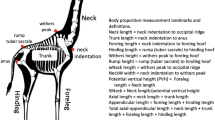Abstract
Classical genetic analysis of a cross between the C57BL/6J and the C3H/21bg inbred strains was used to examine the relative amounts of additive genetic and dominance variance for traits associated with the cricadian rhythm of body temperature. Traits involved with the timing mechanism (amplitude, time of peak temperature, and degree to which lights-off was anticipated) exhibited substantial heritability and little dominance. The overall average body temperature had near-zero heritability and exhibited overdominance. We conclude that although the average body temperature appears to be fixed at a genetic maximum, it provides a simple index of rhythm parameters which are amenable to further genetic analysis which is critical to out understanding of factors contributing to the organization of rhythms and associated behaviors.
Similar content being viewed by others
References
Aschoff, J., Hoffman, K., Pohl, H., and Wever, R. (1975). Re-entrainment of circadian rhythms after phase-shifts of the Zeitgeber.Chronobiologia 2:23–78.
Bruce, V. G. (1972). Mutants of the biological clock inChlamydomonas reinhardi.Genetics 70:537–548.
Connolly, M. S., and Lynch, C. B. (1981). Circadian variation of strain differences in body temperature and activity in mice.Physiol. Behav. 27:1045–1049.
Connolly, M. S., Lynch, C. B., Knight, D. W., and Hotz, M. M. (1982). Adaptation to restricted feeding: C57BL mice adapt while C3H mice starve.Behav. Genet. 12:580.
Feldman, J. F., and Hoyle, M. N. (1973). Isolation and circadian clock mutants ofNeurospora crassa.Genetics 75:605–613.
Halberg, F., Johnson, E. A., Nelson, W., and Sothern, R. (1972). Autorhythmometry procedures for physiologic self-measurements and their analysis.Physiol. Teach. 1:1–11.
Hammel, H. T. (1968). Regulation of internal body temperature.Annu. Rev. Physiol. 30:641–710.
Hegmann, J. P., and Possidente, B. (1981). Estimating genetic correlations from inbred strains.Behav. Genet. 11:103–114.
Hotz, M. M., Connolly, M. S., and Lynch, C. B. (1983). Meal-timing in competition with lighting cycle has differential effects on circadian body temperature rhythms in C57BL and C3H mice.Behav. Genet. 13 (in press).
Konopka, R. J., and Benzer, S. (1971). Clock mutants ofDrosophila melanogastor.Proc. Natl. Acad. Sci. 68:2112–2116.
Kyriacou, C. P., and Hall, J. C. (1980). Circadian rhythm mutations inDrosophila melanogaster affect short-term fluctuations in the male's courtship song.Proc. Natl. Acad. Sci. 77:6729–6733.
Lacy, R. C., and Lynch C. B. (1978). Developmental and acclimation effects of ambient temperature on temperature regulation of mice selected for high and low levels of nestbuilding.J. Comp. Physiol. 123:185–192.
Lacy, R. C., and Lynch, C. B. (1979). Quantitative genetic analysis of temperature regulation inMus musculus. I. Partitioning of variance.Genetics 91:743–753.
Lynch, C. B., Sulzbach, D. S., and Connolly, M. S. (1981). Validity and precision of estimates of genetic parameters from inbred and random-bred populations.Behav. Genet..11:605.
Mather, K., and Jinks, J. L. (1971).Biometrical Genetics, 2nd ed., Chapman and Hall, London.
McClearn, G. E., and DeFries, J. C. (1973).Introduction to Behavioral Genetics, W. H. Freeman, San Francisco.
Moore-Ede, M. C., Schmelzer, W. S., Kass, D. A., and Herd, J. A. (1976). Internal organization of the circadian timing system in multicellular animals.Fed. Proc. 35:2333–2338.
Oliverio, A., and Malorni, W. (1979). Wheel running and sleep in two strains of mice: Plasticity and rigidity in the expression of circadian rhythmicity.Brain Res. 163:121–133.
Possidente, B., and Hegmann, J. P. (1980). Circadian complexes: Circadian rhythms under common gene contron.J. Comp. Physiol. 139:121–125.
Whitney, G., McClearn, G. E., and DeFries, J. C. (1970). Heritability of alcohol preference in laboratory mice and rats.J. Hered. 61:165–169.
Author information
Authors and Affiliations
Additional information
This research was supported by National Institutes of Health Grant GM 21993. C.B.L. is the recipient of NIH Research Career Development Award ES 00042.
Rights and permissions
About this article
Cite this article
Connolly, M.S., Lynch, C.B. Classical genetic analysis of circadian body temperature rhythms in mice. Behav Genet 13, 491–500 (1983). https://doi.org/10.1007/BF01065924
Received:
Accepted:
Issue Date:
DOI: https://doi.org/10.1007/BF01065924




